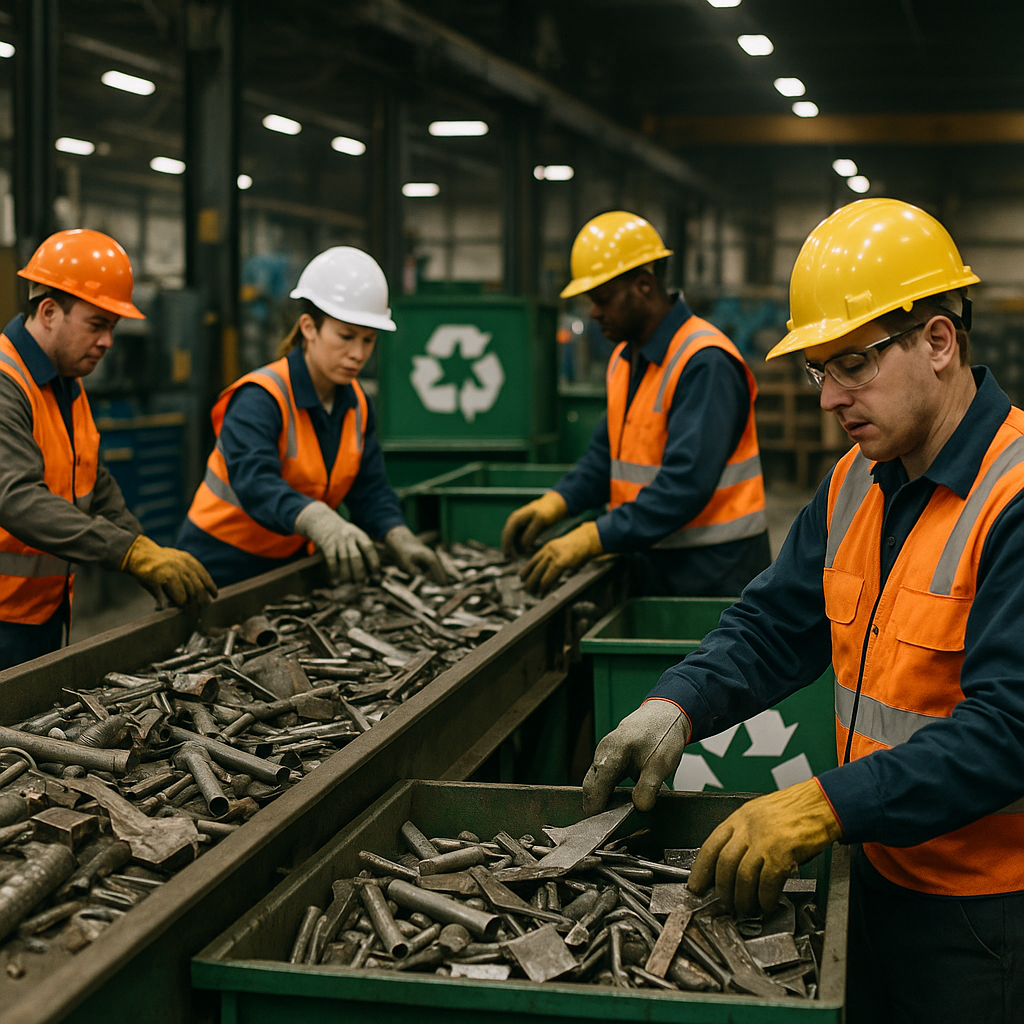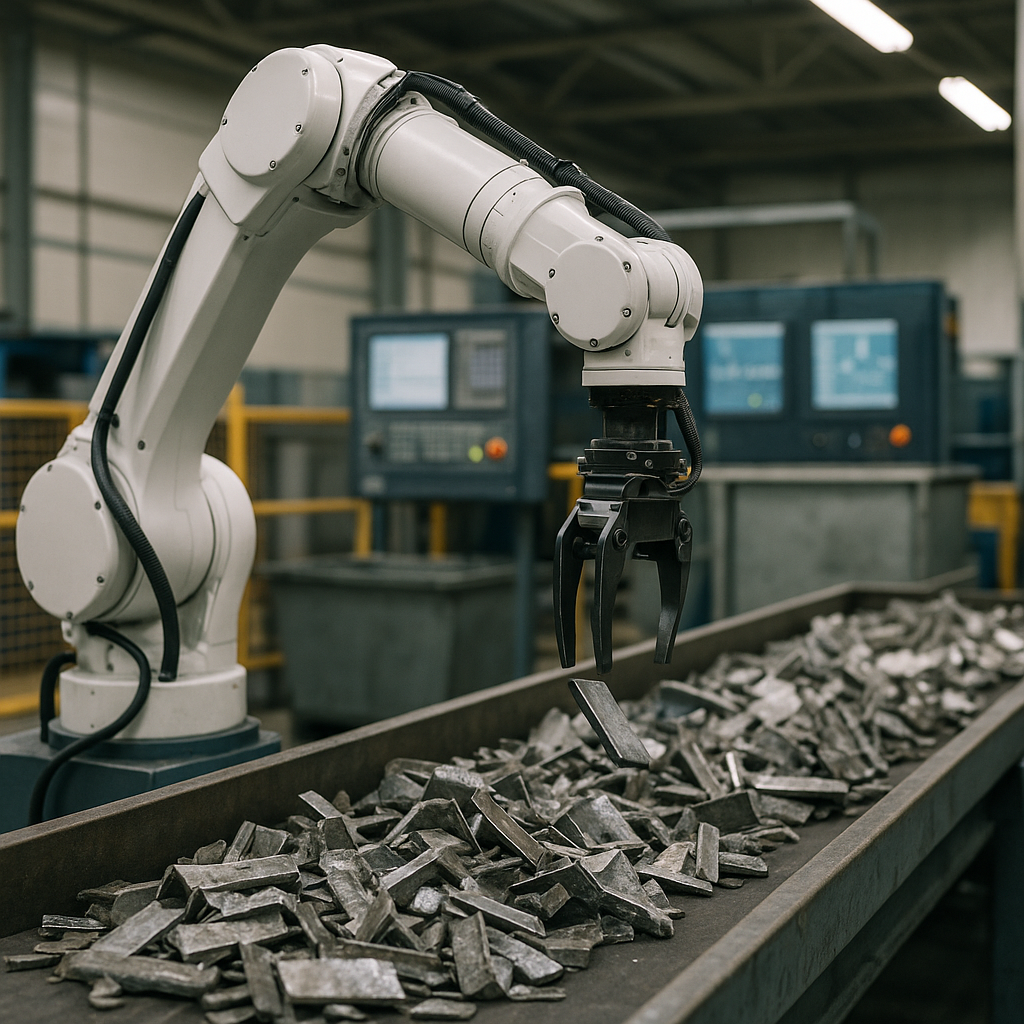5901 Botham Jean Blvd, Dallas, TX 75215
What Are Steel Waste Reduction Strategies?
May 28, 2025The steel industry faces a significant environmental challenge. As a cornerstone of global industrial development, it generates nearly 8% of global emissions within the energy sector and accounts for about 30% of industrial carbon emissions. This substantial environmental footprint demands immediate attention and innovative solutions.
Steel waste reduction strategies are forward-thinking approaches that aim to minimize waste and enhance sustainability throughout the steel production lifecycle. These strategies are not merely environmental initiatives but essential business practices for an industry looking to thrive in a carbon-constrained world.
At their core, steel waste reduction strategies embrace circular economy principles. Instead of following the traditional linear model of take-make-dispose, these strategies focus on keeping materials in use for as long as possible. They incorporate advanced recycling technologies, resource-efficient production methods, and innovative waste management techniques to transform what was once considered waste into valuable resources.
How Does the Circular Economy Approach Reduce Steel Waste?

The circular economy approach in steel manufacturing creates a closed-loop system where materials continuously cycle through production. This strategy contrasts with traditional linear models where resources follow a take-make-dispose pathway. The steel industry offers a promising opportunity for circular economy implementation due to steel’s inherent recyclability.
At its core, the circular economy in steel production focuses on extending material lifecycles through strategic recycling and repurposing. Steel can be recycled almost indefinitely without losing its structural integrity or chemical properties, making it ideal for circular systems where waste is minimized through continuous reuse.
In practical terms, steel manufacturers implementing circular economy principles achieve up to 90% material reuse rates, leading to significant waste reduction. By using Electric Arc Furnace technology instead of traditional blast furnaces, companies can produce steel primarily from recycled materials, reducing the demand for virgin resources.
Closed-Loop Systems in Action
Closed-loop systems are central to circular steel production. These systems carefully track materials throughout their lifecycle, ensuring they return to production rather than becoming waste. Companies establish dedicated material recovery facilities to sort, process, and reintegrate steel scrap directly back into manufacturing.
The benefits extend beyond simple recycling. Advanced sorting techniques allow manufacturers to recover valuable alloying elements like chromium, nickel, and molybdenum from stainless steels. This strategic materials management reduces dependency on new, energy-intensive primary raw materials while preserving the performance qualities of finished steel.
Some steel producers implement scrap return programs with their customers. These collaborative initiatives establish direct pathways for used steel products to return to production facilities, reducing transportation and handling costs and strengthening business relationships through shared environmental goals.
By-Product Utilization
Effective circular economy implementation goes beyond recycling the primary metal. Steel production generates various by-products that traditional manufacturing would treat as waste. Steel slag is the most significant of these by-products, with millions of tons produced annually worldwide.
Rather than disposing of slag in landfills, circular economy approaches find productive uses for this material. Road construction is one of the most widespread applications, where slag serves as an aggregate in asphalt and concrete mixes. Its durability and strength make it particularly suitable for highway construction and areas with heavy traffic loads.
In agriculture, processed steel slag provides valuable soil amendments. Its high calcium and magnesium content helps neutralize acidic soils, while trace minerals support plant growth. Farmers use slag-based products to improve soil structure and enhance crop yields without introducing synthetic chemicals.
The cement industry also utilizes steel slag as a raw material substitute. When properly processed, slag can replace portions of the limestone and clay typically used in cement production, reducing the carbon footprint of both steel and cement manufacturing while conserving natural mineral resources.
Resource and Energy Conservation
The resource conservation benefits of circular steel production extend beyond direct material savings. Recycling steel requires about 60% less energy compared to producing steel from iron ore, leading to lower production costs and decreased carbon emissions.
Water conservation is another crucial advantage. Steel plants implementing circular principles install water recirculation systems that minimize freshwater consumption. These closed water loops reduce both the environmental impact of water sourcing and the energy costs associated with water treatment.
By eliminating intermediate transportation and storage processes, circular steel production further reduces its environmental footprint. The continuous material flow within closed systems minimizes the energy expenses and emissions associated with moving materials between separate facilities.
Economic and Environmental Results
The circular economy approach provides measurable waste reduction outcomes in the steel industry. Studies indicate companies can divert approximately 97% of their solid and liquid production waste from landfills through comprehensive circular programs. This dramatic waste reduction benefits both the environment and the company’s bottom line through reduced disposal costs.
Emissions decrease significantly under circular models. The combination of energy savings from recycling, reduced transportation needs, and decreased landfill volumes results in substantial carbon reductions. Steel companies committed to circular principles report greenhouse gas reductions aligned with the targets established in the Paris Agreement.
By optimizing the weight of steel products through advanced design and manufacturing techniques, circular approaches further enhance resource efficiency. High-strength steels developed through this process allow for lighter applications in vehicles and construction, extending the material efficiency benefits throughout the product lifecycle.
| Application | Utilization of Steel Slag |
| Construction | Used as aggregate in asphalt and concrete mixes for road construction |
| Agriculture | Provides soil amendments with high calcium and magnesium content |
| Cement Industry | Replaces portions of limestone and clay in cement production |
What Advanced Recycling Technologies are Reducing Steel Waste?

Electric Arc Furnaces (EAFs) are a major advancement in steel recycling technology. These furnaces use recycled steel scrap as their primary input, making them significantly more energy-efficient than traditional blast furnaces. Modern EAFs feature improved insulation and advanced electrode control systems to boost efficiency further.
The environmental benefits of EAFs are considerable. Some facilities with new electrode technology have reduced energy consumption by 12% and cut carbon emissions by 18% per ton of steel produced. This technology is essential for more sustainable steel production.
Direct reduction processes offer another promising method for reducing steel waste. These processes can transform iron ore into direct reduced iron (DRI) without the extensive carbon footprint of traditional methods. When combined with EAFs, direct reduction creates a more sustainable production pathway, significantly decreasing reliance on raw materials.
Hydrogen-based steelmaking is at the forefront of advanced recycling technology in the industry. This innovative approach uses hydrogen as a reducing agent instead of conventional carbon sources. The process emits water vapor instead of carbon dioxide, potentially eliminating up to 95% of carbon emissions associated with steel production.
Shaft furnace hydrogen direct reduction (H-DR) technology has emerged as particularly promising. This method builds upon established industrial direct reduction processes like Midrex and HYL but replaces natural gas with hydrogen. Studies indicate that using 100% hydrogen in the shaft furnace process could reduce direct CO2 emissions by up to 91%.
The steel industry is beginning to implement these advanced technologies across various facilities. A Swedish steel producer has piloted hydrogen-based steel production, showing a 50% reduction in CO2 emissions compared to conventional methods. Companies like ThyssenKrupp have started injecting hydrogen into blast furnace operations, although completely replacing coke remains challenging.
Circular economy principles are also being applied to steel production. These approaches focus on extending steel product lifecycles through continuous recycling and reprocessing. The aim is to create closed-loop systems where steel products are perpetually recycled, reducing the need for virgin materials and minimizing waste.
What Challenges and Opportunities Exist in Steel Waste Reduction?

The steel industry faces several significant challenges in its waste reduction efforts. High implementation costs are one of the most formidable barriers. Advanced sorting technologies, automated recycling systems, and modernized processing facilities require substantial capital investment that many companies struggle to justify in their short-term financial planning.
Infrastructure inadequacies present another major obstacle. Many existing facilities were designed decades ago without today’s sustainability standards in mind. Upgrading these systems requires not just money but also production downtime, affecting overall operational efficiency and revenue.
Regulatory complexities create additional hurdles. Companies must navigate a maze of environmental regulations that vary across regions and countries. Compliance often requires specialized knowledge and resources, particularly challenging for smaller operations within the steel supply chain.
Financial Implications of Waste Reduction
The cost-benefit analysis for waste reduction initiatives remains complicated. While the long-term advantages are clear, the immediate financial burden can be prohibitive. A typical steel mill might need to invest millions in high-efficiency electric arc furnaces or advanced slag processing equipment, with return on investment taking several years.
Market volatility adds another layer of uncertainty. Fluctuating steel prices can impact the economic viability of recycling operations, making it difficult for businesses to commit to long-term sustainability investments when short-term profitability might be at risk.
Labor and training requirements present additional costs. Workers need specialized training to operate new technologies efficiently and safely, adding to the overall expense of implementing waste reduction strategies.
Opportunities Through Innovation
Despite these challenges, significant opportunities exist. Technological innovation continues to drive efficiency improvements and cost reductions in recycling processes. AI-powered sorting systems can now identify and separate different grades of steel with remarkable accuracy, increasing the value of recovered materials.
Resource recovery advances offer promising developments. New techniques for extracting valuable elements like chromium, nickel, and molybdenum from steel by-products create additional revenue streams that can offset implementation costs.
Collaborative research partnerships between industry and academic institutions are yielding breakthrough technologies. These joint efforts combine practical industry knowledge with scientific expertise to develop more efficient and cost-effective waste reduction solutions.
The Path Forward Through Collaboration
Industry collaboration presents one of the most promising avenues for progress. When companies share best practices and development costs, they can implement solutions that would be prohibitively expensive for individual organizations. Industry associations are increasingly facilitating these partnerships through knowledge-sharing platforms and joint research initiatives.
Government support plays a crucial role in addressing financial barriers. Many countries now offer tax incentives, grants, and subsidies to companies investing in sustainable technologies. These programs can significantly reduce the financial burden of implementing waste reduction measures.
Public-private partnerships offer another collaborative model. When government agencies partner with steel producers on pilot projects, they create showcases that demonstrate the feasibility and benefits of new waste reduction approaches.
Stakeholder engagement across the value chain is essential. When steel producers work with suppliers, customers, and waste management specialists, they can develop integrated solutions that address waste reduction at multiple points in the product lifecycle.
Policy reforms can create more favorable conditions for investment in sustainable technologies. Streamlined permitting processes and consistent regulatory frameworks help businesses plan and implement waste reduction strategies with greater confidence.
Consumer and market demands increasingly reward sustainable practices. As more customers prioritize environmental responsibility in their purchasing decisions, steel companies that demonstrate leadership in waste reduction gain competitive advantages in the marketplace.
Conclusion: The Future of Steel Waste Reduction
The steel industry is advancing sustainability through strategic waste reduction initiatives. By adopting circular economy principles, manufacturers are turning byproducts like slag into valuable resources for road construction and agriculture. Advanced recycling technologies, especially electric arc furnaces, are significantly reducing energy consumption and carbon emissions compared to traditional methods.
Waste heat recovery systems and carbon capture technologies further demonstrate the industry’s commitment to environmental stewardship. These innovations not only minimize ecological impact but also enhance operational efficiency. The rise of hydrogen-based steelmaking and direct reduction processes signals a promising future for green steel manufacturing as the sector continues to balance economic viability with environmental responsibility.
For businesses looking to implement sustainable waste management practices for steel and other metals, contact Okon Recycling at 214-717-4083.
